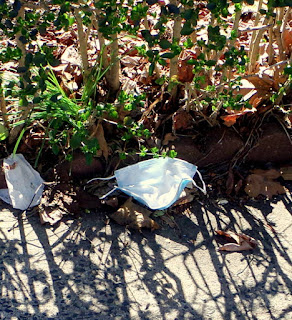At the beginning of this month, plastic bags were the rage.
That is: New York State took the bold step at eliminating single-use ones in
most stores. Despite being an inconvenience for many people, this action seemed sensible and—the truth be told—long overdue. Riding the subway on its elevated sections
in wintertime was a sufficient eye-opener. Gazing out its windows supplied a not-very-pleasing panorama of leafless
trees with countless plastic bags entangled in them.
Plastic bags in trees, landfills, and the oceans
are—temporarily at least—yesterday’s news. Although most shoppers have
transitioned to the reusable kinds, plastic bags are again available in my
favorite market. I guess the state has more urgent priorities now, like
enforcing its social-distancing dictum. Speaking of which, a short while ago I
encountered a neighbor of mine. He appeared positively terrified that I might engage him in
conversation. A little small talk from a safe distance—about life in the
pandemic—probably wouldn’t have done any harm, but none was forthcoming.
If it isn’t one thing it’s another. Now there are discarded
latex gloves and face masks all over the place. And, I fear, coming to a tree
near you. The worst of the litter-azzi are these ubiquitous car-service
guys, many of whom aren’t acquainted with a trashcan. For years, these
inconsiderate slobs have been discarding their lunch remains and lottery ticket
stubs on sidewalks throughout the city. Open the passenger door and plop goes
the garbage. Sadly, gloves and masks have been added to their curbside waste.
Speaking of the gloves being off, I witnessed an argument
between an older black man, whom I’ll call Tyrone, and an older white man, whom I’ll call Morris. From what I observed, the disagreement had nothing to do with race or any such thing.
Rather, it concerned a not particularly long pedestrian bench—a two- to
three-seater tops—on Broadway. Apparently, Tyrone was there
first and the somewhat obese Morris—who had a walker—chose to sit right beside him.
Initially, I thought Tyrone’s grievance was that we are in the midst of a
pandemic and supposed to stay at least six feet apart of one another, not two
feet on a cold metal bench in the great outdoors.
I heard Morris say, “Where do you want me to sit?” Tyrone
replied, “There’s a bench across the street!” It seemed that Tyrone’s main gripe
was that Morris lit a cigarette. Sorry, Morris, but I’m with Tyrone here for a
whole host of reasons. I know you are overweight with ambulatory issues, but
Tyrone was sitting there first. And, Morris, have you heard about the
coronavirus?
The epilogue to this tale of woe is that after I did my
grocery shopping a short distance away, Tyrone was sitting alone on the bench.
I looked across the street but saw no sign of Morris. Honestly, Morris seemed a
bit off. And, personally, I wouldn’t sit on a bench on busy Broadway—under
the noisy El—in the healthiest of times.
(Photos from the personal collection of Nicholas Nigro)
(Photos from the personal collection of Nicholas Nigro)















































